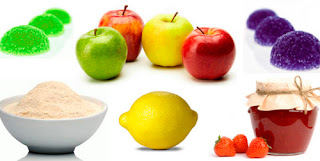tartaric acid - Citric acid:
They are very similar in their origin and in their appearance, citric found in fruits such as lemons, oranges, grapefruits and a lesser amount in strawberries, raspberries, cassis and currants.
Tartaric acid is derived exclusively from grape juice.
Both products are used for acidification candies, to increase the power of gelling pectin and sugar to invest (for invested or fondant sugar).
They are very similar in their origin and in their appearance, citric found in fruits such as lemons, oranges, grapefruits and a lesser amount in strawberries, raspberries, cassis and currants.
Tartaric acid is derived exclusively from grape juice.
Both products are used for acidification candies, to increase the power of gelling pectin and sugar to invest (for invested or fondant sugar).
Lactic acid:
It comes from the fermentation of lactose. Confectionery is underused. legislation should be considered, as in some countries is not authorized to use.
Acetic acid:
It is used in small quantities for use in food should be completely pure and free of mineral substances.
Cream of tartar:
It is part of baking powder. Should be stored in a cool, dry place in tightly closed container, it is used as leavening alone or with sodium bicarbonate.
It is used to stabilize the beaten egg whites to snow, cakes, mousses, meringues and souffles, also to prevent crystallization of sugar confectionery.
Sodium bicarbonate:
It is a component of baking powder. Should be stored in dry and dark places, in combination with other acidic ingredients like milk, a few drops of vinegar, yogurt or cream of tartar make the dough rise in volume.
Baking powder:
Composed of a mixture of alkaline and acid salts, which react upon contact with liquids and heat, and forms a carbon dioxide increases the volume of the mass. It is used for cakes, pastries, cakes, etc.
Ammonium bicarbonate or ammonia:
It should be consumed only comes in powder or stone, as liquid is toxic, is used to weigh and keep dry masses like pastries or cookies vanilla.
In addition they acquire a crispy texture.
Yeast:
It is a microscopic fungus that is primarily used in making bread.
Brewer's yeast is used more often.
With oxygen, yeasts transform sugars into water and carbon dioxide. When added to flour rich in gluten, that carbon dioxide gets locked in the glúten and increases the volume of the mass.
The lower the temperature more levar take baking. The ideal serving temperature is between 25 and 28 ° C.
Agar Agar:
Substance used in making jellies based juices or purees, also in some desserts.
It is obtained from a species of red algae, and bought powder, flakes, rods or filaments. To use it, the liquid in which it is diluted is boiled and simmered melts, it is very rich in iron.
Pectin:
common gelling substance in the plant kingdom and is used to thicken jams and jellies. Pectin marketed comes from the remains of dried apples.
It exists in liquid or crystal form. It can also find a sugar pectin enriched.
The key to good jams and jellies resides in the proportion of sugar, pectin and acids containing the fruits used.
Jelly:
Peter Cooper, self-taught engineer, founder of the first institution of higher learning in the United States, the Cooper Union, and inventor and builder of the famous project locomotive "Tom Thumb", used to demonstrate the potential of the transport system of trains moved steam leaders of the transportation industry in your country. Among other patents, it obtained the manufacture of gelatin in 1845, and some others for manufacturing and production standards.
The preparation of the gelatin is made through a somewhat different procedure starts grinding the bones, cartilage, tendons, are then soaked in a strong base to soften and then subjected to a series of stronger acidic solutions. Then the dough is boiled for hours. This process is properly gelatin extraction.
When the gelatin layer is formed, it is separated from the boiling water and dried until it is powder.
You may add sugar, artificial flavor and color and is ready to become an exquisite dessert.
Otherwise it can be used as unflavored gelatin, which can be used in desserts, creams, meals, etc.
You can also buy the sheets.









No hay comentarios:
Publicar un comentario